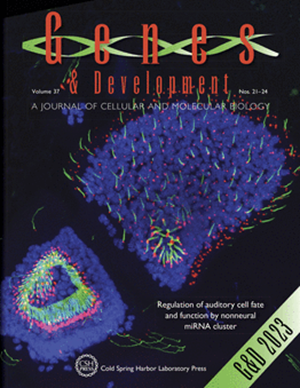Analysis of knockout mice reveals critical female-specific roles for the Hippo pathway component PTPN14
IF 7.7
1区 生物学
Q1 CELL BIOLOGY
引用次数: 0
Abstract
The Hippo pathway regulates many physiological processes, including development, tumor suppression, and wound healing. One understudied Hippo pathway component is PTPN14, an evolutionarily conserved tyrosine phosphatase that inhibits YAP/TAZ. Although it is an established tumor suppressor, PTPN14's role in tissue homeostasis has remained unclear. We thus generated Ptpn14-deficient mice and found that only ∼60% of Ptpn14−/− mice survived postnatally, highlighting the importance of PTPN14 for viability while also enabling the discovery of PTPN14 physiological functions. Ptpn14−/− mice developed debilitating corneal lesions and the uterus defect hydrometra, as well as heart and kidney abnormalities. Ptpn14 deficiency precipitated an impaired injury response in the cornea and dysregulated YAP signaling in both the uterus and the cornea. Notably, these phenotypes were female-specific, revealing sexually dimorphic Hippo pathway function through PTPN14. Finally, analysis of human PTPN14 variants suggested that PTPN14's essential roles are conserved in humans, underscoring the importance of our insights for designing therapies to improve women's health.对敲除小鼠的分析揭示了Hippo通路成分PTPN14的关键雌性特异性作用
Hippo通路调节许多生理过程,包括发育、肿瘤抑制和伤口愈合。一个未被充分研究的Hippo通路成分是PTPN14,这是一种进化上保守的酪氨酸磷酸酶,可抑制YAP/TAZ。虽然PTPN14是一种确定的肿瘤抑制因子,但其在组织稳态中的作用尚不清楚。因此,我们产生了Ptpn14缺陷小鼠,发现只有约60%的Ptpn14−/−小鼠在出生后存活,突出了Ptpn14对生存能力的重要性,同时也使Ptpn14的生理功能得以发现。Ptpn14−/−小鼠出现衰弱性角膜病变和子宫水肿,以及心脏和肾脏异常。Ptpn14缺乏导致角膜损伤反应受损,子宫和角膜中YAP信号失调。值得注意的是,这些表型是雌性特异性的,通过PTPN14揭示了性别二态的河马通路功能。最后,对人类PTPN14变异的分析表明,PTPN14的基本作用在人类中是保守的,这强调了我们对设计改善女性健康的治疗方法的重要性。
本文章由计算机程序翻译,如有差异,请以英文原文为准。
求助全文
约1分钟内获得全文
求助全文
来源期刊

Genes & development
生物-发育生物学
CiteScore
17.50
自引率
1.90%
发文量
71
审稿时长
3-6 weeks
期刊介绍:
Genes & Development is a research journal published in association with The Genetics Society. It publishes high-quality research papers in the areas of molecular biology, molecular genetics, and related fields. The journal features various research formats including Research papers, short Research Communications, and Resource/Methodology papers.
Genes & Development has gained recognition and is considered as one of the Top Five Research Journals in the field of Molecular Biology and Genetics. It has an impressive Impact Factor of 12.89. The journal is ranked #2 among Developmental Biology research journals, #5 in Genetics and Heredity, and is among the Top 20 in Cell Biology (according to ISI Journal Citation Reports®, 2021).
 求助内容:
求助内容: 应助结果提醒方式:
应助结果提醒方式:


